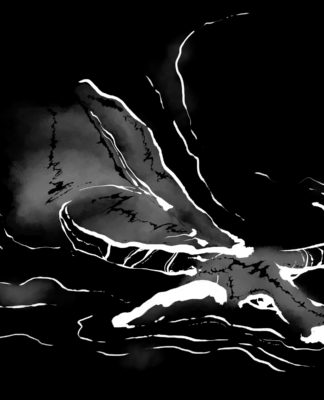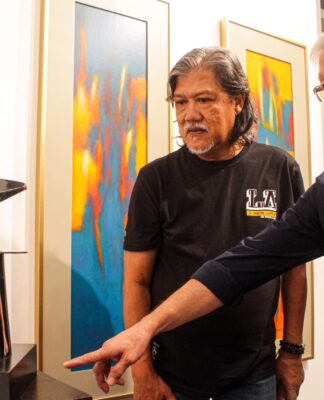A GOOD 10-minute walk from UST, Dangwa, or Dos Castillas St. Flower Market, boasts of blossoms and posies at student-friendly prices: from 50 bucks a bundle of Malaysian mums to 200 bucks for an exquisite bouquet—good enough tokens to tingle affection.
Named after a transportation company owned by incumbent Benguet Rep. Samuel Dangwa, the tranco at the left end of the street carries fresh flowers from the chilly mountains of Baguio twice everyday to the “Dangwa” market in Manila.
What once was an eight-vendor roadway in the 80’s has transformed into a three paved block of 100 stalls.
“A far cry from what Dos Castillas used to look like,” Lubania Lantok, an old resident, said of the street. “Back then, there were only eight flower vendors selling flowers here, and they all lived right here in Dos Castillas.”
In 2006, Mayor Lito Atienza declared Dos Castillas as the “flower market of Manila,” making the place more consumer-friendly by installing large tulip-shaped lampposts in the middle of a brick tiled road covering two blocks of Dos Castillas street to provide customers with ample space to move between stalls without the inconvenience of crossing streets.
After World War II crippled the gold mining industry in Benguet, the country’s gold production capital, many of the locals turned to agriculture and floriculture.
The Dangwa Transportation Company and the government-owned Benguet Auto Lane (BAL) became the main support facility to the mining areas and to the whole Mountain Province.
Owned by 72-year-old Samuel Martin Dangwa, a Kanakaney, or a native of the highlands of Benguet, Dangwa Tranco’s first years of operation transported vegetables (strawberries, beans, potatoes, and carrots) grown by Benguet farmers to Manila everyday.
But in the early 1980’s, florists from the highlands started to see the financial advantage of selling the native-grown flowers in bulk in Manila.
For many of the farmers, cutflowers were called “green gold” because of their profitable returns. A starting capital of P20,000 would yield twice in profits, enough money for the flower growers to buy their own vehicles to transport the flowers to Manila.
According to the annual Cutflower Industry Situationer Report, cutflowers coming from the Northern region accounted for 70 per cent of the floral supply in Manila, while 100 per cent of orchids and asters in Dangwa come from Batangas and Laguna, respectively.
“It was my cousin who told me to sell flowers so that he could plant them,” said 79-year-old Lantok, who has been selling flowers at Dangwa for 32 years. “And until now, the flowers we sell still come from that farm.”
Lantok rented a house located just beside the gates of the Dangwa bus station so she could be one of the first vendors to receive the load of flowers from Baguio.
Just from her flower shop, she was able to send her five children to good schools.
According to Lantok, the flowers used to be stored in the bus’ luggage compartment inside pails of water for the nine-hour trip from Baguio to Manila. They were unloaded at 3 a.m. in the morning into the waiting arms of the Dangwa vendors.
“It’s enjoyable here. You get to entertain customers. Here, time flies. You never get bored,” Cabanatuan vendor Florentino Pasco said.
Dangwa is now open 24/7, and is barely without people haggling for a reasonable price over a dozen or two bouquets, Valentines or not.
As the flower market has thrived over the years, with the number of flower vendors increasing and raising the stakes of competition, many vendors have tapped suppliers other than Baguio, importing flowers from China, Korea, and Holland.
Rosy lives
Not only flowers but many lives have bloomed because of the flower market. Flower vendors and traders have sent their children to UST.
Like Lantok , Leonora Moreto-Capuloy has spent most of her life selling Baguio blooms. Capuloy has been a flower vendor for 23 years and she has been residing in her stall for as long as she could remember.
Like most vendors in Dangwa, she stumbled upon the trade by chance.
“I saw my friends setting up businesses in Dangwa. I told myself, if they can do it, why can’t I?” she said.
Capuloy said that it was through her livelihood that she was able to send three of her six daughters to UST. They are proud Pharmacy, Nursing and Secondary Education graduates.
Despite the increasing number of flower sellers, Capuloy considers her fellow vendors as survivors like herself.
“I don’t consider them as competitors, I am here to survive with them,” she said.
For 15 years, 41-year-old Maria Nabia has sat on the same stool, right beside the curb of Dimasalang street, sorting out wilted anthuriums from the fresh ones. She has a lot to thank about Dangwa—for it was through it that she was able to send her four children to school as well.
Getting flowers from her hometown in Los Baños, Nabia was a first-hand witness of the good and bad effects brought about by the “aesthetic constructions” in Dangwa.
“It was easier to sell years before, but now, it’s very hard,” she said.
With stiff competition from over a hundred stalls offering the same flowers and the same services, Nabia is forced to lower prices, even to the point of selling her goods at the price she bought it.
“It is only during occasions like Valentine’s that we can make up for the loss,” she said.
As people sift through shops for bargain prices at night, the tulip-shaped light posts lining the middle of the street serve as enduring beacons of the legacy left by a bus station, which has given meaning and livelihood to many people and let many a hearts bloom. Raychel Ria C. Agramon and Mary Joy T. de Lara with reports from http://www2.mozcom.com/~melvian/ early_recollections.htm

















